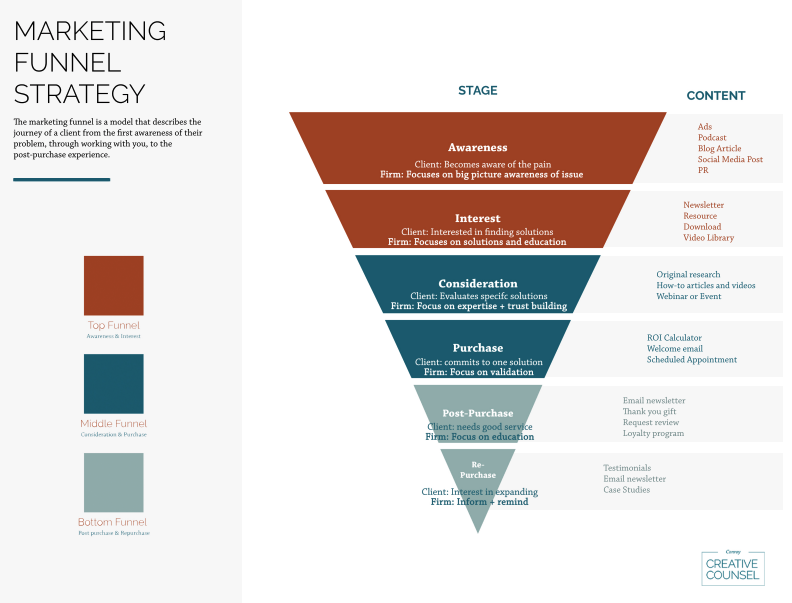In today’s digital age, the first interaction a prospective client often has with a law firm is through its website. This makes a law firm’s website a pivotal asset in building a professional relationship.
A successful law firm website is more than an online brochure; it is a platform that reflects the firm’s values, expertise and professionalism. It does so by providing easy access to information about the law firm’s practice areas, services and its attorneys. Such accessibility is crucial in an age where website visitors seek immediate answers and reassurance about their legal concerns.
In this blog, we will explore ten essential features every law firm website should have. We will delve into what it takes to create a robust online presence that resonates with clients, and what it is that can distinguish your site from most law firm websites in an increasingly competitive legal landscape.
We will cover the following topics:
- User-friendly Design
- Attorney Bios
- Defined Practice Area Pages
- Clear Calls to Action (CTAs)
- Chat Widgets and Contact Forms
- Content Strategy: Blogs & Articles
- Testimonials and Reviews
- SEO Optimization
- Security and Privacy Features
- Analytics and Performance Tracking
1. User-Friendly Design
➡️ Importance of an Intuitive, Easy-to-Navigate Website:
The design of a law firm’s website should prioritise user-friendliness. In a sector where clients are often seeking guidance in stressful or complex situations, the last thing they need is a website that is difficult to navigate.
- Easy Navigation: An intuitive design ensures that visitors can easily find the information they are looking for, such as practice areas, attorney profiles and contact details.
- Prioritizing Client Need: This ease of navigation not only enhances the user experience but also reflects the firm’s understanding and consideration of its clients’ needs.
➡️ Mobile Responsiveness and Its Impact on Client Accessibility:
Considering that more than half of the world’s internet users access the web via a mobile phone, mobile responsiveness is no longer optional – it is essential.
- Automatic Adjustment: A mobile-responsive website automatically adjusts its layout, images, and content to fit the screen size on which it is being viewed, ensuring that the site is easily accessible and readable on any device.
- User Appeal: This responsiveness not only improves user experience but also caters to the growing number of clients who use their mobile devices for legal research and finding legal services.
- Accessibility: It also demonstrates the firm’s commitment to accessibility, keeping it connected with a broader client base.
➡️ Visual Elements That Contribute to User Experience:
The visual design of a law firm’s website plays a crucial role in setting the tone for client interactions.
- The Power of Visual Elements: This includes the choice of color scheme, layout, typography, and imagery. These elements should be chosen to convey professionalism and trustworthiness. For instance, a clean and modern layout with a conservative color palette can project a sense of reliability and formality.
- Imagery: High-quality images and graphics can be used to break up text and make the site more engaging, but they should be used judiciously to maintain a professional look.
- Typography: Typography should be legible and professional, enhancing the overall readability of the website.
A well-designed website is an indispensable tool in a law firm’s marketing strategy, directly influencing how clients perceive and interact with the firm.
2. Attorney Bios
➡️ The Significance of Detailed Attorney Profiles:
Attorney bios are a critical component of any law firm’s website, serving as a vital connection point between the firm and its potential clients.
- A Platform for Introduction: These profiles provide a platform for attorneys to showcase their expertise, experience, and qualifications.
- Building Credibility: Detailed bios help in building credibility and trust with prospective clients.
- Personalization: They allow visitors to understand who will be handling their legal matters, what specific experience the attorneys bring, and how their background aligns with the client’s needs.
- Transparency: This transparency is essential in the legal field, where the choice of an attorney can significantly impact the outcome of a case.
➡️ Presenting Credentials and Experience Compellingly:
When crafting attorney bios, it is important to present credentials and experience in a manner that is both informative and engaging.
- Achievements: This can include outlining their education, years of practice, notable cases, and any awards or recognitions received.
- Storytelling: However, it’s not just about listing achievements; it is also about telling a story. The bio should weave these elements together in a narrative that highlights the attorney’s journey, expertise, and the value they bring to their clients.
- Jargon-free Language: Using clear, concise language free of legal jargon makes the attorney bios accessible and relatable to a broader audience.
➡️ Incorporating Personal Touches to Build Trust:
While professional achievements are important, adding personal touches to attorney bios can significantly enhance their effectiveness.
- Personal Elements:: This might include mentioning hobbies, volunteer work, or reasons for choosing a career in law.
- Relatability: Such details help humanize the attorneys, making them more approachable and relatable to clients.
- Personal Connections: It is these personal connections that often build trust and comfort, crucial factors in a client’s decision-making process.
- Competitive Edge: Personal touches also help in differentiating each attorney’s unique personality and approach, further personalizing the client’s experience with the firm.
By effectively combining professional credentials with personal elements, these profiles not only highlight the attorneys’ expertise and accomplishments but also establish a more personal and relatable image of them.
3. Defined Practice Area Pages
➡️ Necessity of Clear, Concise Information on Legal Services Offered:
Defined practice area pages are essential for any law firm website, as they provide potential clients with a clear understanding of the services the law firm offers. These pages should be designed to convey information about each practice area in a straightforward and accessible manner.
- Clear, concise descriptions help clients quickly ascertain whether the firm can handle their specific legal issues. This clarity is crucial in helping clients make informed decisions about their legal representation and in setting realistic expectations about the scope of services the firm provides.
➡️ Tips for Organizing Practice Areas for Easy Navigation:
Organization of these practice area pages is key to ensuring a user-friendly experience.
✅ Here are a few top tips:
- Categorization: Group similar services together under broader categories to simplify navigation.
- Hierarchy: Use a clear hierarchy in headings and subheadings to guide readers through the content.
- Consistent Format: Keep a consistent format across all practice area pages for coherence.
- Search Functionality: Incorporate a search bar to help users quickly find specific services. It is important to have a clear navigation to help site visitors access content without feeling overwhelmed.
- Linking: Use internal links to guide visitors to related areas of practice or relevant attorney bios.
- Accessibility: Ensure all content is accessible, including to those with disabilities, by following web accessibility standards.
➡️ Importance of Including Case Studies or Success Stories:
Incorporating case studies or success stories on practice area pages can be highly effective. These real-life examples serve multiple purposes:
- Demonstrate Expertise: They showcase the firm’s experience and capability in handling cases similar to those of potential clients.
- Build Credibility: Success stories act as social proof, enhancing the firm’s credibility.
- Engage Emotionally: They connect with potential clients on an emotional level, illustrating how the firm has positively impacted the lives of others.
- Clarify Services: Case studies provide concrete examples of how legal issues are handled, offering clarity on what clients can expect.
In summary, well-defined practice area pages are crucial for law firm websites. These pages not only inform potential clients about the firm’s services but also play a significant role in building trust and demonstrating the firm’s expertise and successful track record.
4. Clear Calls to Action (CTAs)
➡️ Understanding the Role of CTAs in Guiding Visitor Behavior:
Calls to Action (CTAs) are essential elements in web design, particularly for law firm websites.
- They serve as guides, directing visitors towards specific actions you want them to take, such as contacting the firm, scheduling a consultation, or learning more about a service.
- Effective CTAs can significantly influence visitor engagement and conversion rates.
- They act as signposts that lead potential clients through the website, ultimately guiding them towards establishing a connection with the firm.
- A well-placed CTA removes ambiguity and provides a clear path for visitors to follow, facilitating a smoother user experience.
➡️ Examples of Effective CTAs for Law Firms:
For a law firm, CTAs should be clear, concise, and action-oriented. Some examples include:
- “Schedule a Free Consultation”: Encourages direct engagement with potential clients.
- “Learn More About Our Practice Areas”: Guides visitors to detailed service descriptions.
- “Download Our Legal Guide”: Offers valuable resources while capturing visitor information.
- “Contact Us for Case Evaluation”: Provides a straightforward way for clients to initiate a legal inquiry.
- “Subscribe to Our Newsletter”: Keeps interested visitors engaged over time.
- “Read Our Client Testimonials”: Builds trust and credibility through social proof.
➡️ Placement and Frequency of CTAs Throughout the Site:
The placement and frequency of CTAs are crucial for maximizing their effectiveness. Here are some guidelines:
- Visibility: Place CTAs in prominent locations where they are easily seen, such as the top of the homepage, within the main navigation, or as a floating button.
- Contextual Relevance: Include CTAs within relevant content sections. For example, a CTA for a free consultation can be placed on practice area pages.
- Balance: While it is important to have CTAs throughout the site, they should be used judiciously to avoid overwhelming the visitor. Too many CTAs can be counterproductive, diluting their impact and potentially leading to decision fatigue.
- Testing and Optimization: Regularly test different CTA styles, placements, and wording to see which combinations are most effective in driving engagement and conversions.
In conclusion, clear and strategically placed CTAs are critical for guiding visitor behavior and encouraging engagement on a law firm’s website. They should be designed to stand out and align with the firm’s goals, ensuring that potential clients are smoothly transitioned from website visitors to engaged clients.
5. Chat Widgets and Contact Forms
➡️ Advantages of Live Chat Widgets for Immediate Engagement:
Live chat widgets are an increasingly popular feature on law firm websites, offering several advantages for client engagement:
- Instant Communication: They provide immediate access to assistance, which is particularly valuable for potential clients seeking quick answers.
- Increased Engagement: Live chats can engage visitors at key moments, keeping them on the site longer and increasing the likelihood of converting them into clients.
- Convenience: They offer a convenient and less intimidating way for clients to initiate contact compared to phone calls or emails.
- Gathering Insights: Chat widgets can be a source of valuable insights into common concerns or questions clients have, informing both customer service and content strategies.
➡️ Designing User-Friendly Contact Forms for Lead Generation:
Contact forms are a staple for lead generation on law firm websites. Their design should focus on user-friendliness. Here’s how:
- Simplicity: Keep the form simple with a minimal number of fields to reduce friction and increase the likelihood of completion.
- Clarity: Clearly label each field and use straightforward language to avoid any confusion.
- Relevance: Only ask for information that is necessary for the initial consultation or contact, such as name, email, and a brief description of the legal issue.
- Privacy: Include a privacy statement reassuring visitors that their information will be kept confidential and secure.
- Confirmation: Provide a clear confirmation message or page after submission, so users know their inquiry has been successfully received.
➡️ Balancing Automation with Personalization in Client Interactions:
While automation in chat widgets and contact forms can enhance efficiency, balancing this with personalization is key for the following reasons:
- Personalized Responses: Ensure automated responses in chat widgets are as personalized as possible. They should acknowledge the client’s query and provide relevant information, not just generic replies.
- Human Touch: Offer an option to speak with a real person for more complex inquiries. This can be through scheduling a call or transferring to a live chat with a staff member.
- Follow-up Communications: Use the information provided in contact forms to personalize follow-up communications, whether it’s an email or a phone call. Addressing clients by name and referencing their specific legal issues shows attentiveness and care.
By offering immediate, convenient ways to communicate and balancing automated features with a personalized touch, firms can effectively nurture client relationships right from the start.
6. Content Strategy: Blogs & Articles
➡️ Role of Content in Establishing Expertise and Improving SEO:
A well-planned content strategy, featuring informational blog posts and articles, plays a pivotal role in a law firm’s online presence. Quality content serves two primary purposes:
- Establishing Expertise: By publishing informative and insightful articles on various legal topics, a law firm can showcase its knowledge and expertise in the field. This helps in building trust with potential clients who are seeking reliable and authoritative sources of legal information.
- Improving SEO (Search Engine Optimization): Regularly updated content enriched with relevant keywords can significantly enhance a firm’s visibility on search engines. SEO-driven content attracts more organic traffic to the website, making the firm more discoverable to potential clients searching for legal assistance.
➡️ Suggestions for Blog Topics Relevant to Target Clients:
Choosing the right topics for blogs and articles is crucial in engaging the target audience. Here are some suggestions:
- Legal Guides for Common Issues: Write about common legal challenges your target audience faces, offering guidance and advice.
- Case Law Updates: Provide insights on recent case law or legislative changes that could impact clients.
- FAQs in Practice Areas: Address frequently asked questions in your firm’s key practice areas.
- Client Success Stories: Share anonymized success stories or case studies that highlight the firm’s experience and effectiveness.
- Legal Tips and Advice: Offer practical legal tips or advice that can help clients in their day-to-day lives.
- Industry-Specific Legal Analysis: For firms specializing in certain industries, provide analysis on legal issues affecting those sectors.
➡️ Consistency and Quality in Content Creation:
Maintaining consistency and quality in content creation is essential:
- Consistency: Develop a content calendar to regularly publish new articles and blogs. This consistency helps in keeping the audience engaged and improves SEO rankings.
- Quality: Ensure that all content is well-researched, accurate, and provides real value to the reader. The content should be written in an accessible language, avoiding excessive legal jargon.
- Engaging Format: Use a format that is easy to read, with headings, subheadings, bullet points, and images where appropriate. This enhances the readability and engagement of the articles.
- Authorship: Consider having different attorneys write on their areas of expertise. This not only diversifies the content but also showcases the breadth of knowledge within the firm.
In short, a strategic approach to content creation, with an emphasis on relevance, consistency, and quality, can significantly enhance a law firm’s credibility and online visibility. This, in turn, positions your law firm as a thought leader in the legal field, attracting and educating potential clients.
7. Testimonials and Reviews
➡️ The Impact of Client Testimonials and Reviews on Credibility:
Positive feedback from past clients serves as social proof, reassuring potential clients of the firm’s competence and quality of service.
- Real-World Examples: These real-world endorsements can be more influential than self-promotional content, as they provide an authentic, client-centered perspective.
- Building Reputation: Testimonials and reviews help in building a reputation, as they reflect actual experiences and satisfaction of clients, which can be a decisive factor for others seeking legal services.
➡️ Ethical Considerations and Best Practices in Showcasing Client Feedback:
While testimonials and reviews are valuable, law firms must navigate ethical considerations and adhere to best practices. Here’s how to do this:
- Compliance with Legal and Ethical Guidelines: Ensure that all testimonials and reviews comply with the legal and ethical standards set by state bar associations or relevant legal authorities. Some jurisdictions may have specific rules regarding the use of client testimonials in legal marketing.
- Consent and Anonymity: Obtain explicit consent from clients before using their feedback on the website. Consider the sensitivity of legal matters and respect client privacy by offering the option of anonymity or using initials instead of full names.
- Accuracy and Authenticity: Testimonials should be genuine and accurately reflect the client’s opinions. Avoid altering or cherry-picking feedback to misrepresent the client’s views.
- Contextual Relevance: Place testimonials in relevant sections of the website. For instance, a testimonial about successful litigation outcomes can be more impactful on a page dedicated to litigation services.
- Regular Updates: Keep the testimonials and reviews updated. Outdated feedback may not accurately reflect the current state of your law firm’s services.
- Responding to Reviews: If the platform allows, consider responding to reviews, both positive and negative. A professional and thoughtful response to feedback demonstrates your firm’s commitment to client satisfaction and openness to improvement.
- Diverse Perspectives: Showcase a range of testimonials that reflect the diversity of your firm’s client base and areas of practice. This not only enhances credibility but also illustrates the firm’s ability to handle a variety of cases and clients.
In summary, when used ethically and effectively, client testimonials and reviews can greatly enhance a law firm’s credibility. They offer potential clients a glimpse into the experiences of others, helping to build trust and confidence in the firm’s abilities.
8. SEO Optimization
➡️ Basics of SEO for Law Firms:
Search Engine Optimization (SEO) is a critical aspect of digital marketing for law firms, ensuring that their websites are visible and rank highly in search engine results. SEO involves optimizing various elements of a website — from its content and structure to its technical setup — to increase its attractiveness to search engines like Google. Key components of SEO for law firms include:
- High-Quality Content: Regularly publishing relevant, informative content helps in establishing authority and improving search rankings.
- Keywords: Identifying and using the right keywords that potential clients are likely to use when searching for legal services.
- On-Page Optimization: This includes optimizing title tags, meta descriptions, headers, and images to improve relevance to search queries.
- Mobile-Friendliness: Ensuring the website is responsive and provides a good user experience on mobile devices.
- Site Speed: Optimizing website loading times, as faster sites are favored by search engines.
- Secure Website (HTTPS): Having a secure site is important for user trust and for search engine rankings.
➡️ Keyword Strategy and its Importance for Online Visibility:
A well-thought-out keyword strategy is crucial for law firms to enhance their online visibility. This involves:
- Keyword Research: Identifying the terms and phrases that potential clients use when searching for legal services. Tools like Google Keyword Planner can be helpful in this research.
- Long-Tail Keywords: Incorporating specific, longer phrases that are less competitive but highly relevant to the firm’s services. For example, “personal injury lawyer in [City Name]”.
- Incorporation in Content: Strategically use these keywords in website content, blogs, and articles, making sure that their use is natural and contextually appropriate.
➡️ Utilizing Local SEO for Community-Based Practices:
Local SEO is particularly important for law firms that serve specific geographic areas. It involves optimizing the firm’s online presence to appear in local search results. This includes:
- Google My Business Profile: Creating and maintaining a detailed Google My Business profile with accurate and up-to-date information about the law firm.
- Local Keywords: Using location-based keywords in the website’s content and metadata.
- Local Link Building: Gaining backlinks from local businesses, directories, and publications to enhance local relevance.
- Reviews and Ratings: Encouraging satisfied clients to leave reviews on Google and other relevant platforms, as positive reviews can boost local search rankings.
9. Security and Privacy Features
➡️ Importance of Website Security in Protecting Client Information:
In the legal industry, where sensitive client information is frequently handled, the security of a law firm’s website is of utmost importance. A breach in security can lead to unauthorized access to confidential client data, potentially resulting in legal liabilities and damage to the firm’s reputation.
Here are key reasons why website security is critical:
- Protecting Client Data: Law firms are responsible for safeguarding client information. A secure website ensures that personal and case-related data is protected from cyber threats like hacking or phishing.
- Maintaining Client Trust: Clients trust law firms with sensitive information, and a secure website reinforces this trust. It shows clients that the firm is committed to protecting their privacy and interests.
- Avoiding Legal Ramifications: Data breaches can have significant legal consequences, including penalties under data protection laws.
➡️ Compliance with Legal Industry Standards and Privacy Laws:
Compliance with legal industry standards and privacy laws is another critical aspect of website security. Law firms must ensure their websites comply with various regulations, such as:
- Data Protection Laws: Adherence to laws like the General Data Protection Regulation (GDPR) in the EU, or sector-specific federal laws and state-level laws or similar regulations in the US. This includes obtaining consent for data collection and providing clear privacy policies.
- Ethical Obligations: Compliance with the ethical standards set by legal governing bodies regarding client confidentiality and data protection.
- Industry-Specific Regulations: Following any additional regulations that may apply to legal services in different regions or for different practice areas.
➡️ Implementing Security and Privacy Measures:
To ensure compliance and security, law firms should implement the following measures:
- SSL Certificate: Using SSL (Secure Sockets Layer) encryption to secure data transmission between the user’s browser and the website.
- Regular Updates and Maintenance: Keeping the website and its security features regularly updated to protect against new threats.
- Strong Password Policies: Implementing robust password policies for any areas of the site requiring login credentials.
- Data Encryption: Encrypting sensitive data stored on the website or in related databases.
- Backup and Recovery Plans: Having a reliable backup and disaster recovery plan to protect data integrity.
- Training Staff: Educating staff on cybersecurity best practices and data protection protocols.
In summary, by implementing robust security measures and ensuring compliance with legal and ethical standards, law firms can protect sensitive client information and maintain their reputation as trustworthy and responsible legal service providers.
10. Analytics and Performance Tracking
➡️ Using Website Analytics to Understand Client Behavior:
Website analytics play a crucial role in understanding how potential clients interact with a law firm’s website. By analyzing data on user behavior, law firms can gain valuable insights into what attracts visitors, what keeps them engaged, and where they might be losing interest. This information is key to optimizing the website for better performance and client engagement.
Website Analytics can reveal the following:
- Most Visited Pages: Identifying which areas of the website are attracting the most attention.
- User Journey: Understanding the paths visitors take through the website, helps in optimizing the navigation and layout.
- Bounce Rate: Analyzing the rate at which visitors leave the site after viewing only one page, which can indicate issues with content or user experience.
- Conversion Rates: Tracking how many visitors are taking desired actions, such as filling out contact forms or downloading resources.
➡️ Tools and Metrics for Tracking Website Performance:
Several tools and metrics are essential for tracking and analyzing website performance:
- Google Analytics: A widely used tool that provides comprehensive insights into website traffic, user behavior, and conversion metrics.
- Conversion Tracking: Tools like Google Analytics allow law firms to track specific conversions, such as form submissions or newsletter sign-ups, which are crucial for measuring the effectiveness of CTAs and other elements of the site.
- Search Engine Rankings: Monitoring the website’s ranking for key search terms to gauge SEO effectiveness.
- Page Load Time: Using tools to assess the loading speed of the website’s pages, as slower load times can negatively impact user experience and SEO.
- Heatmaps: Tools like Hotjar or Crazy Egg provide heatmaps that visually represent where users are clicking and how far they are scrolling, offering insights into how they interact with the site.
- User Feedback: Incorporating tools to gather direct user feedback can provide qualitative insights into user experience and satisfaction.
➡️ Implementing Changes Based on Analytics:
The data gathered from these tools should inform decisions on website changes and improvements. For instance:
✅ If analytics show that certain pages have high bounce rates, those pages might need better content or design.
✅ Understanding which content drives the most engagement can guide the content strategy.
✅ If the data shows low conversion rates, it might be time to revise CTAs or the contact form layout.
In summary, website analytics and performance tracking are indispensable for a law firm’s website management. They provide objective data that can be used to make informed decisions about how to improve the site, ultimately leading to better client engagement and conversion rates.
How Conroy Creative Counsel Can Help Your Law Firm
Are you ready to elevate your law firm’s online presence and attract more clients?
With our expertise in law firm marketing, we understand the unique challenges and opportunities your firm faces in the digital world. From designing a user-friendly website to implementing effective SEO strategies, we are dedicated to helping your law firm stand out in a crowded market.
Don’t let your website get lost in the digital space, transform it into a dynamic tool that drives client engagement and grows your practice.
Get in Touch Today
Visit us at Conroy Creative Counsel to discover how we can turn your website into your law firm’s most powerful asset for success.
Contact us today and let’s work together to create a website that not only looks great but also delivers results!





















